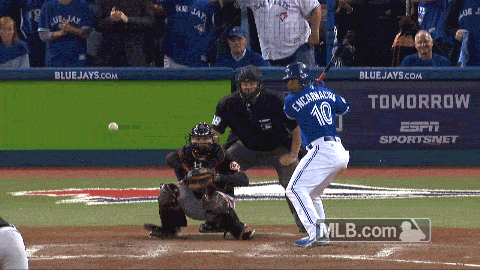Exactly. Showalter could've used Britton there and probably had a better chance of getting out of it, but he kept him for the potential save situation and paid for it. And yeah, some people rightly dragged him for not using his best pitcher in the most precarious situation, but he and others also defended the decision because it wasn't save situation and that's what you're "supposed" to do.
I also know that someone's going to cite Jordan Romano's save situation vs non-save splits, but those are relatively small samples (just over and just under 100 innings respectively) and we don't know what other factors are at play (save situations are almost always coming into a clean start of the 9th. Non-save situations are more likely to be entering in high-leverage jams with baserunners and/or strong parts of the lineup queuing up.)
Generally speaking, historical evidence and analysis suggests that while on the whole closers tend to perform a bit worse in non-save situations than save situations, the difference is usually not big enough to be all that significant and not consistent enough to label players as "needing the pressure" vs "not being cut out to close" or anything else. Mariano freaking Rivera, mythologized greatest closer ever who had liquid nitrogen in his veins and exuded a field that halted cosmic entropy, had seasons where his save situation performance outdid his non-save output
and vice versa. Pitchers tend towards being worse in non-save outings but it's not a given and there's no evidence that it's controllable or repeatable with confidence.
Have you ever wondered whether closers are less determined to get the job done in non-save situations? I certainly have, and it's all Casey Janssen 's fault...

bleacherreport.com
We have all heard people comment that Closers™do worse in non-save situations. Is it actually true? How true is it? Here’s a little off-day exercise to explore this phenomenon. The Data First, we have to pick Closers™. (OK… this trademark thing is going to get old really soon… so I’ll stop) The...

bravesjournal.com
How well do closers perform in non-save situations? Can we observe evidence of the legendary "closer mentality" in those pitchers who perform better in save situations than in blowouts?

www.beyondtheboxscore.com
A recent BTBS study found no difference between closers' performance in close and late games and their performance in all other situations. Does the same relation hold when we look at other relievers' performance?

www.beyondtheboxscore.com
As we chronicled in Baseball Prospectus 2000, the current thinking on how to build and run a major-league bullpen may be changing. For 20 years, teams have used their "closer"–a term originally used to designate a team’s best reliever–more and more exclusively in what we call "save situations:"...

www.baseballprospectus.com
fun side note is that while the save situation and its value and necessity tends to come down on the side of staunch traditionalism, this wasn't always the case. As recently as the 1970s teams used their best relievers as "firemen" who were charged with coming into tense situations and working out of them no matter the inning or whether or not there was a statistical benchmark to mine value individual from. It wasn't until the 80s or even into the 90s (
the 80s saw the dawn of league save leaders getting 30+ saves with regularity. the 90s was when that threshold was pushed to 40+) that the save statistic picked up steam and became embedded in the consciousness of the sport as important or necessary or immutable and in doing so created the idea of the rigidly structured bullpen where everyone had an inning or a job that was set and not situational. And this was after like a decade of the stat trying to gain acceptance among an unwilling fan and user-base as MLB had adopted it into its lexicon of official stats in 1969. The establishment fought the save for the better part of 10 years as newfangled and disruptive to the true way to play and measure the game until they didn't. And now it's as much a part of baseball as wins and losses, RBIs, or the way that the Yankees get to ignore park construction rules on the basis of grandfathering in a stadium built decades after the rules were enforced (which also pre-dated a major renovation of their previous stadium that should've been made to abide by the new restrictions).
For the sake of comparison, the designated hitter, the bane of staunch baseball traditionalists everywhere and responsible for ruining the game by taking the offensive nuance out of it, was adopted by the AL in 1973.
The DH is only like 3 or 4 years younger than the save. But somehow baseball people accepted the save in the decade after the DH came into existence and now treat it as a concrete pillar of baseball history while the DH has perpetually remained a newfangled abomination against the true design of the game.
EDIT: I should probably also loop in material from my favorite sister-issue to the above: the value of the save itself. Because it's always worthwhile to know that historically speaking teams have won games where they've had a save situation (up by >4 runs heading into the potentially final inning) at about a 95% pace consistently all the way back to time immemorial (or the founding of MLB, whichever came first).
One question has fascinated me for a while now: How much have modern closers changed the game? I mean, sure, we know they have changed many things SURROUNDING the game in obvious ways. Closers have...
web.archive.org
From K-Rod to Mariano to Joe Nathan, many closers are having dominating seasons. Jim Caple isn't impressed.
www.espn.com
Whether it was your starter pitching the whole game because bullpens were for losers or injuries, the advent of the fireman, the rise of the singular dominating closer, or the modern slightly-less-focused closer-by-committee era, the chances of you winning a game when you have a save situation in play is about the same for every size of lead you may have. the magical, mythological dominance of guys built to shut down the 9th and keep the other team on the wrong end of the result has not created an uptick in the rate at which those victories is secured.
Closers picking up saves and thus being hailed as the reason that leads are safe in the 9th is every bit as sensible a conclusion as the idea that this rock I have in my hand is preventing my house from being attacked by tigers.








